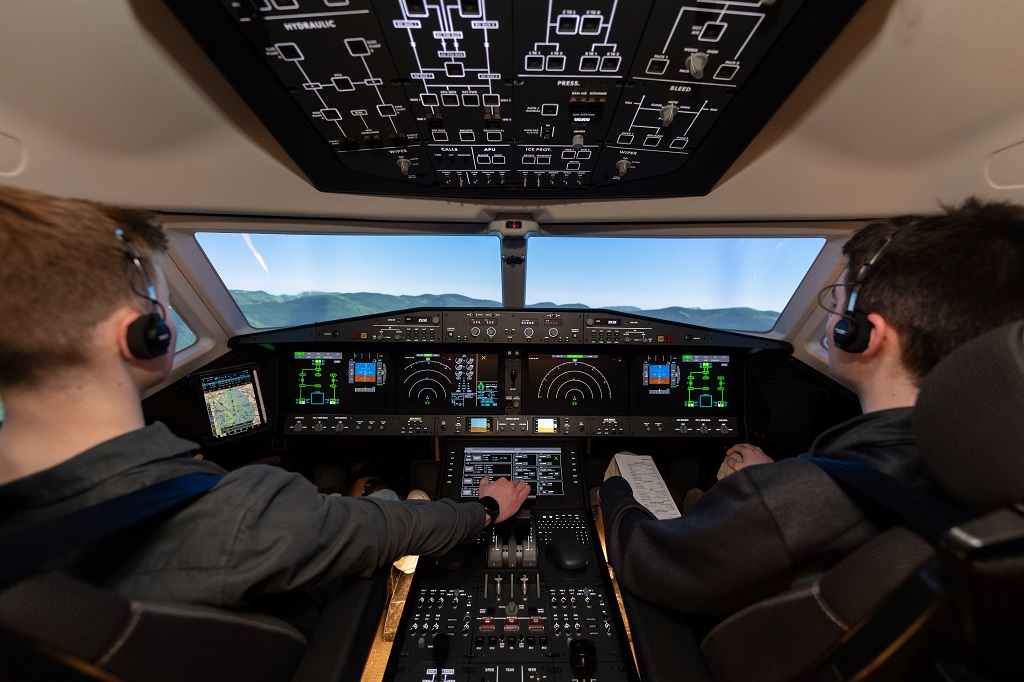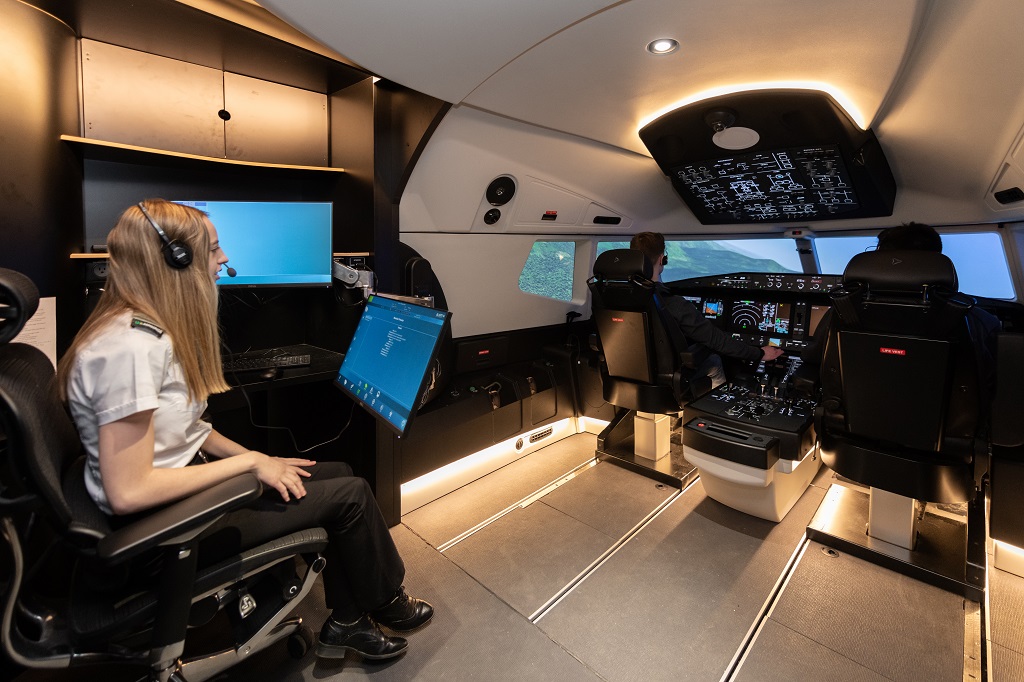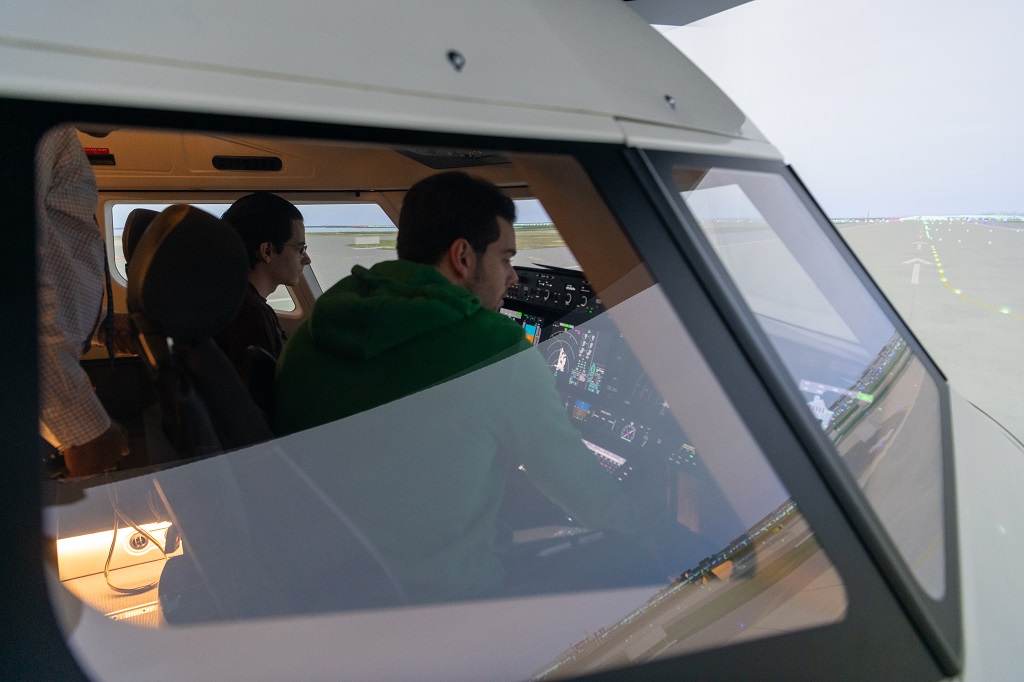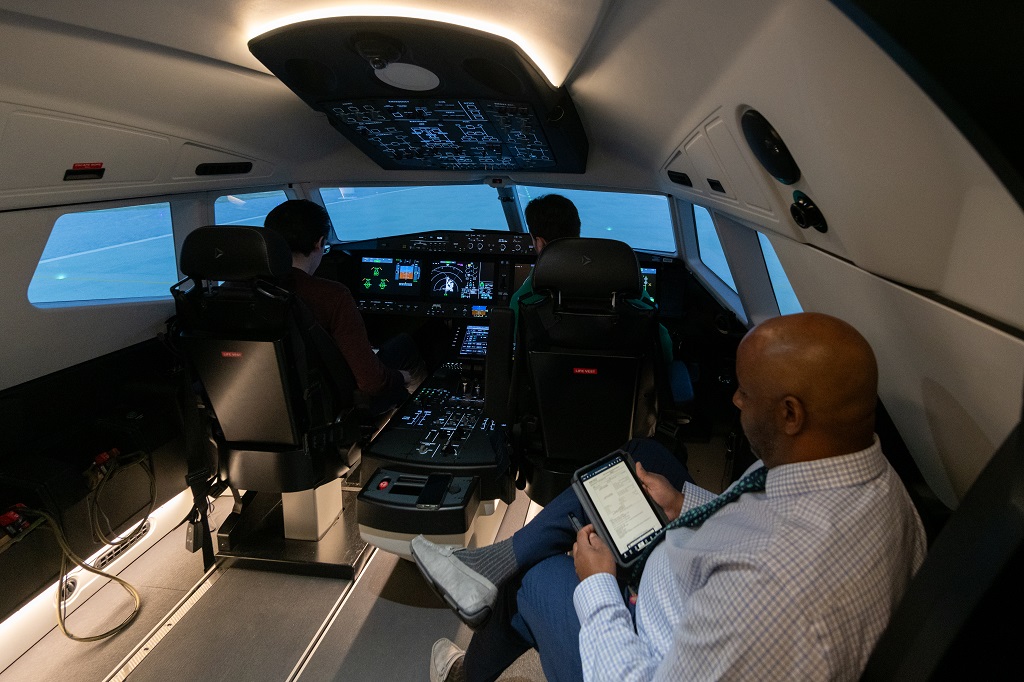Inside UND’s new commercial-jet simulator
First of its kind in North America, the ALSIM can be configured to simulate either Airbus or Boeing’s newest aircraft

By Averie Eixenberger
“Demand for airliners soars,” read a headline in The Wall Street Journal in June. And as one Airbus executive confirmed in the story, “We cannot make planes fast enough.”
Given those sentiments and the fact that Boeing forecasts demand for 42,600 new commercial jets over next 20 years, the question arises: Who will train the pilots to fly those planes?
We don’t know the full answer to that question. But we do know part of the answer, and it’s this:
UND.
In fact, UND’s Commercial Aviation students now can learn to operate those aircraft by practicing on a state-of-the-art simulator that’s more realistic than ever before.
This week, the first Commercial Aviation students at the John D. Odegard School of Aerospace got the chance to experience training in the brand new ALSIM, learning skills that will help them throughout their career.

First of its kind
The first of its kind in North America, the ALSIM is a French-made trainer that simulates the operation of major commercial jetliners. The simulator is customizable, allowing it to simulate the cockpit of either an Airbus or Boeing aircraft.
“The main attractive feature of the sim is that it’s flexible,” said Andreas Anagnostos, one of the UND students on the flight. “It can switch between the A320 and 737 training philosophies. We operated it in the A320 configuration.”
The ALSIM creates an extremely realistic training experience. It features a completely enclosed cockpit, allowing students to immerse themselves in the environment without distractions. Sitting within, it becomes easy to forget that it is not a real aircraft.
“The realism is amazing,” said instructor Alan Murray. “You can program a whole flight from departure to landing. It will simulate the parameters of what we enter in – even the weight and balance. If we program it with a certain amount of fuel and weight, it will react accordingly.”
The ALSIM can be customized to any environment that might be encountered during flight. It can be programed to simulate different airports, weather, other traffic and much more. Students can practice all sorts of situations, even taxiing directly to a gate at an airport.
Throughout the flight, instructors with industry experience give instructions and advice on how to operate a large jet, allowing students to learn in a safe way.
“You are learning how to fly a jet,” said UND student Mason Plowman. “You can work out the kinks and find out what works and what doesn’t before you get into an actual airliner. It’s a lower stakes environment where you can learn and make mistakes.”
The ALSIM even features emergency equipment, allowing students to practice emergency responses while remaining safe on the ground.

Crew Resource Management-capable
As Anagnostos and Plowman ran through their procedures, they were given the chance to practice Crew Resource Management or CRM. This training procedure is used by airline pilots every day and is a way of dividing tasks among crew members to improve safety.
“We are actually running it as a crew environment,” said Plowman. “In most of our training, we are trying to achieve single pilot ratings, but we don’t get a lot of experience in the CRM environment – which for many of us will be the bulk of our careers. Here, we are learning how to work in a team in a practical setting.”
“A lot of the training at UND focuses on the theory of CRM, but there is very little of that actually going on in the aircraft through most of the training,” added Anagnostos.
“If you think about your future job, that is all you are expected to do. You have to operate as a crew and operate well in order to ensure safety.
“Getting the chance to practice that here will prepare you for your career and start transitioning you into a team mindset.”
The excitement of both students and instructor was palpable. The ALSIM will be an addition to the CRJ 200 simulator that the university has been using for more than 20 years. With advancements in technology and changes within the industry, the ALSIM provides valuable flexibility as the university enters a new era within aviation.

“The CRJ has very little automation, whereas most airliners now are highly automated,” said Anagnosotos. “The experience in the ALSIM is more akin to what you will experience in your career.”
Both students remarked on how important this experience is to transition to an airline career after graduation.
“The regionals are becoming less of a steppingstone, so the ALSIM models an aircraft that you might go directly to,” stated Plowman.
“Getting the opportunity to practice on an aircraft that I could be potentially flying within a year or so is invaluable,” said Anagnostos. “Now all of the ‘uncertainty’ in trying to transition from general aviation to airline flying happens here, instead of on the job.”
The ALSIM marks a new step in hands-on learning for students, preparing them for a career before they even get on the job.
“It’s invaluable for transitioning to the real world of flying,” said Murray.
“By having this class available, the first time you go through training at the airlines, you are more likely to pass because you have been through all the maneuvers before. Students will be way ahead of the game by going through this course.”
 About the author:
About the author:
Averie Eixenberger is a Commercial Aviation and English major at UND. After graduation, she hopes to pursue a career as an airline pilot and work within aviation journalism.


